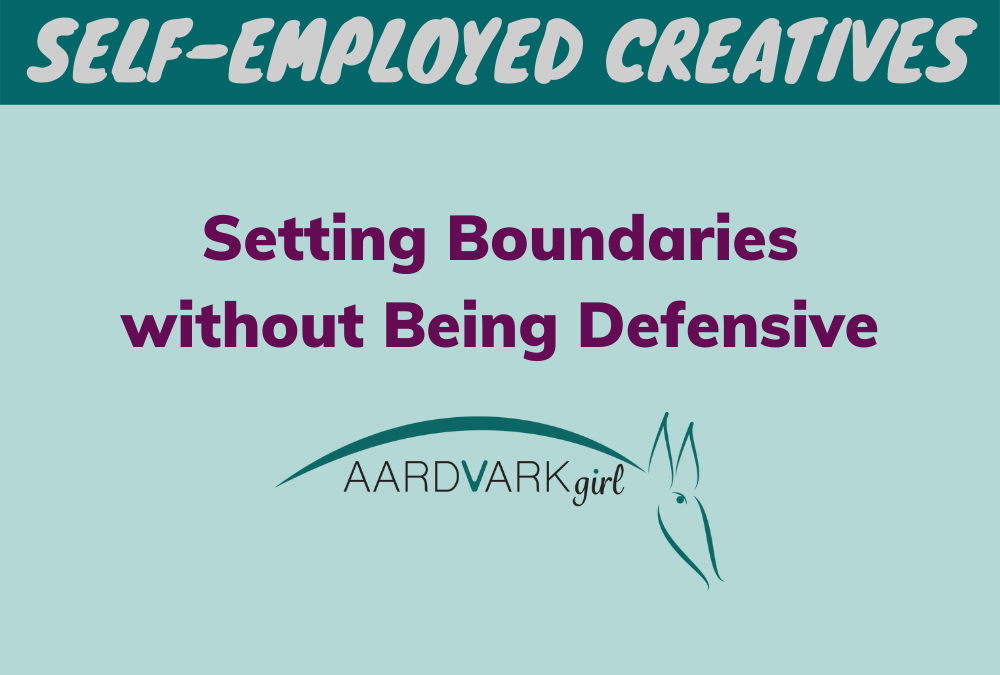We all know I have a lot of favorite things about being self-employed. On that list is being able to set your own rules for how you run your business. You get to choose your hours, your location, how you communicate, which systems work for you, and everything else. It’s way better than having to fit the mold that someone else controls and might not align with what is right for you. But, that doesn’t mean that you get your way all the time. If that’s what you are expecting, and you get defensive when someone needs you to do something differently, you will end up creating challenges that don’t need to exist.
Two important skills I talk about a lot are communication and setting boundaries. I call them both skills because there is a nuance to doing them correctly. Everyone can communicate, but it doesn’t mean they can do it well. Same with setting boundaries. When you’re dealing with people every day, whether they are clients or vendors, you have to be able to communicate effectively and set healthy boundaries to protect yourself and make sure those relationships are in a good place. One of the best ways to do that is to keep your negative emotions in check and don’t use them to fuel your interactions. It’s much better to go into discussions from a neutral place, listen to what the other person says, and explain your point of view in a more logical way.
For the record, this applies to non-business relationships as well.
Emotional vs Logical Responses
I’ll use a common occurrence to explain what I mean by keeping it logical vs emotional. The client wants you to attend a meeting at their office. You know that it’s a waste of your time to drive all the way there when you can accomplish the same goal in an email or phone call. So how do you respond?
Response 1: Not setting a boundary would mean you go anyway but the whole time you’re thinking about how you don’t want to be there and how much time it’s taking away from everything else you need to do. Chances are your client will pick up on that demeanor and interpret it as a behavioral issue.
Response 2: Reacting emotionally would be sighing at the request or going into a diatribe about how you don’t like in-person meetings and how you have so much to do and it would be an inconvenience to you. Basically making it all about you instead of considering what’s good for them. And since they are paying you, they probably won’t appreciate that.
Response 3: A logical, client-friendly response would be to explain that the time it would take to travel to and from a meeting at their office would take away from the work you need to do for them. Offer the solution of discussing their agenda at the same time, but on the phone or Zoom instead, assuring them that you’ll be able to accomplish the same goals without hindering progress on their project.
With the logical response, you’re making it about the client and helping them see that you are looking out for them. They might not have considered the extra time it would take you because they’re already at the office. Or they might work better in a group setting and assume you’ll find the same value in a situation that will actually slow you down. Or they might just want to see you because they like you, so they think offering the invitation is a nice gesture.
You might even ask them if it’s important for it to be in person, or why they feel it needs to be in person, and see what they say. I find that nearly every time, that’s just what they’re used to and they hadn’t put any other thought into it at all. I usually hear, “Oh, no reason. A call or Zoom is fine.” You never want to assume you know the intention behind a request, or react negatively based on an assumption. It’s always better to just ask.
So, not setting a boundary would mean you’re doing something you don’t want to do, and maybe didn’t even have to do, and you’ll possibly end up resentful for it even though you didn’t try to help yourself. Responding emotionally can make it sound like you don’t care about your client and are just being stubborn. But communicating logically can help you understand where they are coming from, help them understand where you’re coming from, and can often land with a win for everyone.
You can do whatever you want, but that doesn’t mean it’s right.
One mistake I keep seeing, usually with those who are newer to business, but also with some who have been doing it for a while, is this undertone of defensiveness when a client wants them to do something in a different way. It’s that emotional response that comes across almost like a tantrum. “I don’t want to do it this way.” “I can have rules, too.” “I’m allowed to do it like this!”
I see this in business groups on social media all the time. Someone asks for advice and a lot of the comments end up being something like, “It doesn’t matter what your client needs. You can do whatever you want because it’s your business.” And then others jump in and are like, “Yeah, you do what you want and they just need to accept it.” It’s meant to be encouraging, because so many people do struggle with saying no or having conversations where they don’t give in to what the client wants. But it’s not always helpful. It is true that you can do whatever you want, but that doesn’t mean it’s right. At least not in every situation.
This attitude most likely stems from resentment we have from our old jobs, where we weren’t respected or valued or had to do things a certain way even when we could do it better if the people in charge would just offer a little flexibility or trust. I know all too well how that goes. It’s easy to feel like you have to overcompensate once you’re out on your own. That you need to put your foot down at every turn so no one takes advantage of you again. Once you have that freedom, you don’t want to give it away. It makes sense.
But sometimes we can be so stubborn about wanting to do things our way that we don’t realize that our way is actually getting in the way. You won’t become successful without compromising sometimes. There must always be some give and take, whether you have the client or are the client. You build those positive relationships by working together to reach your common goals.
Why don’t you want to do it?
The trick is to choose when to stand firm and when to give in. Think about why you don’t want to do something. Is there a logical reason for it or are you just being stubborn?
If you prefer email but you have a client who hates it, what do you gain by refusing to take a phone call? Is it so much of an inconvenience that it’s worth losing business? And I say this as someone who doesn’t like talking on the phone. I communicate my preferences with my clients, but ultimately I need to meet them where they are. I don’t need to be defensive about it because I understand that it isn’t a personal attack on me that our methods are different. My own feelings aside, I prefer email because it’s a written record I can go back and reference any time. But there’s no reason I can’t let my client express his needs on the phone, take notes, and then follow up with an email recapping our discussion. That’s actually a good practice to be in anyway because it ensures you are on the same page and nothing gets misinterpreted or forgotten after the conversation.
If your client needs you to invoice using their platform, but you prefer to use Quickbooks, is that worth arguing about? Many bigger companies have internal payment systems and your choices might be use it or don’t work with them. That’s not the time to be stubborn. I’ve said this many times, but you always want to make it easy for people to pay you. Their intention isn’t to make your life difficult, and it’s not a criticism of the way you do things.
On the other side of that, though, there are times when you do need to push back. If you have a CRM system you use to manage the entire process of a job, something you’ve built through your time and experience because you know it keeps everything running smoothly, that’s something you want to explain rationally to a client who says she doesn’t want to use it. Some people are hesitant to learn new software, but if you can help them see how it will benefit them, they might be more open. In some cases, you may need to let them know that if they are unable to utilize your system, you won’t be able to move forward with them. And these are discussions that should be had before the contract is signed, not after. Manage expectations from the beginning and you’ll avoid more of those uncomfortable conversations later.
No one wants to lose a client over something they feel is silly, but if you can’t perform at your best because someone is unwilling to trust your system, it’s better to walk away. Be confident enough to do that, but still don’t take it personally. That client might not be the right fit for you, and that’s okay. It’s better to know up front than to ignore the red flags and get stuck with a bad client.
It’s all about building long-term relationships where there is mutual respect.
It’s important to set boundaries, but do it without being defensive. You’ve earned the right to do things however you see fit, but don’t overlook the benefits of considering your clients’ needs as well. It’s all about building long-term relationships where there is mutual respect. You help them, they help you, everyone is happy and making all kinds of money. That’s the dream, right? You can have that. You’ve already taken the biggest step by starting your own business. So don’t let the past derail you.
Compromising is not failing. Clients wanting to do things differently is rarely a reflection of you or your process, so there’s no need to get defensive about it. Let go of the emotional reaction and respond logically. Be clear, especially with yourself, about why you feel so strongly about something. If it’s a minor inconvenience, you may want to give in. If it’s a massive disruption to your workflow, enforce your boundaries. It’s always your choice how you want to run your business, but if you expect to always get your way, you might hit more hurdles than are necessary. Communicate your needs, listen to your clients, and you’ll find a way to make it work.

